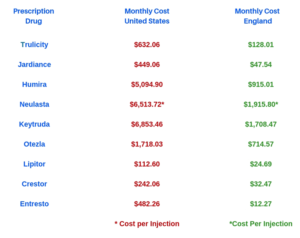
How Much Longer Will We Be Able to Afford the Prescription Drugs We Need?
I am sure you probably have heard how expensive prescription drugs are here in the United States. That prompted me to start researching what you are about to read.
My Personal Interest in This Dates Back to . . .
. . . 2013 and 2014 when my deceased wife, Donna, was being treated for cancer. In November of 2013, Donna was diagnosed with bladder cancer. We consulted with several doctors. They all agreed her bladder had to be removed. However, a course of chemotherapy treatments was recommended before the surgery.
These treatments were designed to kill as many cancer cells as possible. When her bladder was removed, most of the cancer would be gone. Her chance of recovery would be much greater.
Four chemotherapy treatments were scheduled, one every two weeks. These treatments were strong. Donna was at the local cancer center from 8 or 8:30 a.m. till 4 or 4:30 p.m. for each one.
One of the possible side effects of the chemo was Donna’s white blood cells might be damaged. If they were, she would have a higher risk of infection. To prevent infection, Donna had to go to either the hospital or the cancer center on the day following each chemo session for a shot of Neulasta. That shot was like a regular shot. It took less than 5 minutes to inject it into Donna’s arm.
You may have seen commercials for Neulasta on television. A patient is shown at home wearing a device on the back of their arm which administers the drug. A trip to the hospital or cancer center the day after chemo is no longer necessary.
Donna’s health insurance was through Blue Cross and Blue Shield. About a month after the first Neulasta shot, Donna got an explanation of benefits form from Blue Cross and Blue Shield. She gave it to me and I was astounded.
The Hospital’s Charge for the Neulasta Shot was About $20,000 ! ! !
That was more than the charge for the chemotherapy session. Blue Cross and Blue Shield discounted the charge for Neulasta to about $10,000. They ended up paying the hospital a little over $5,000 and the hospital had to accept that as payment in full.
Remember – Donna had 4 chemotherapy sessions. She had to have 4 shots of Neulasta. The charges for each were the same and Blue Cross and Blue Shield handled them the same way. For those 4 shots, Blue Cross Blue Shield paid about $20,000.
The health insurance Donna had was good. We did not suffer because of the cost. At the time, I wondered what a person without insurance would do. I also researched Neulasta on the Internet. In Europe, the cost of a shot was about $1,500.
About $1,500 in Europe Versus About $5,000 Here
Why the difference? Why do we have to pay so much more? There were no valid reasons.
While preparing to write this, I had an idea – I would write down the names of prescription drugs being advertised over and over again on television. I would check on the Internet to see what the monthly charges for each were here in this country. Then I’d find out what the costs were in England.
I Almost Fell out of My Chair by What I Found
Every commercial shows each patient being helped by the drug. None indicate what the cost will be or how the patient can pay for it.
I also found out the price for Neulasta was not the highest. The price for Keytruda was.
As you can see from this chart, the monthly charge for every drug is far more expensive here in the United States.

Drug Manufacturers Set the Price Here – in England, They Don’t
In our country, manufacturers set the prices for their drugs. Under law, Medicaid has the power to negotiate what they will pay for drugs. Medicare does not.
If you look at insurance plans for drugs other than for Medicaid or Medicare, the insurance companies each have to negotiate with the drug manufacturers how much they will pay for each drug. Companies with plans covering large numbers of people can negotiate better deals than companies with plans covering smaller numbers.
The power in drug pricing in this country is in the hands of the drug manufacturers.
It is different in England. There the main buyer of prescription drugs is the government’s health plan. It sells drugs to the British people. The Government plan has in place a National Institute for Health and Clinical Excellence (NICE). Representatives from NICE and drug manufacturers discuss each manufacturer’s prescription drugs and set prices for them.
About 71% of people eligible for Medicare have coverage under Part D, the prescription drug plan through Medicare. Here in Tennessee, current estimates are that between 72 and 75% of those eligible have coverage under Part D.
By Not Voicing Our Concern About the High Cost of Drugs, Our Cost for Medicare Part D Increases
Those of us who have coverage under Part D normally don’t think about how much a drug actually costs. All we have to pay is the copay and that is normally a fraction of the actual cost. We don’t complain because we don’t know and never ask.
By not voicing our concern about the cost of drugs, we indirectly are giving drug companies tacit approval to continue to set the fees for drugs they manufacture without any oversight. As the prices of these drugs remain high and those for other drugs increase, the cost of Medicare Part D increases. We end up paying more for the coverage.
What Happens to the 23 to 25% of Tennesseans Who Can’t Afford Medicare Part D?
Those really impacted are the 23 to 25% of the people in this state who don’t have coverage under Part D. How can they afford any of these drugs if they need them? If a person needs Keytruda, how can they afford the monthly cost of $6,8653.46? How many who need it die earlier because they just can’t afford it?
People living below the poverty line may qualify for government help with their drug costs. The problem is this is not widely publicized. Many who are eligible for it are not taking advantage of it.
Those living slightly above the poverty line have real challenges. Many of the commercials for drugs say the drug manufacturer may be able to help people who can’t afford them. Each drug manufacturer has an application to be completed and submitted. The question is how many people are submitting applications and how many are actually helped?
Enough is Enough
Let the drug manufacturers know you are no longer going to stand idly by and let them charge whatever they want for the drugs they make. Let your congress people and senators know that if the drug industry does not start to regulate itself, they will step in and pass laws to bring drug prices down.
You are doing this not only for yourselves but for your children and their children. There should be no reason a person dies because they cannot afford a medicine they need for a medical condition they have.
Do You Need Help Lowering Your Prescription Drug Costs?
The Affordable Medicine Options for Seniors (AMOS) program can help you find ways to lower your drug costs. Call Peggy Ransom with the Office on Aging at (865) 524-2786.
______________________________
If you have any comments on what you have read in this post, please email them to me. Also – if you have any ideas about subjects you would like to see discussed in future posts, please send me an email and let me know. My email address is bob.ooablog@gmail.com.